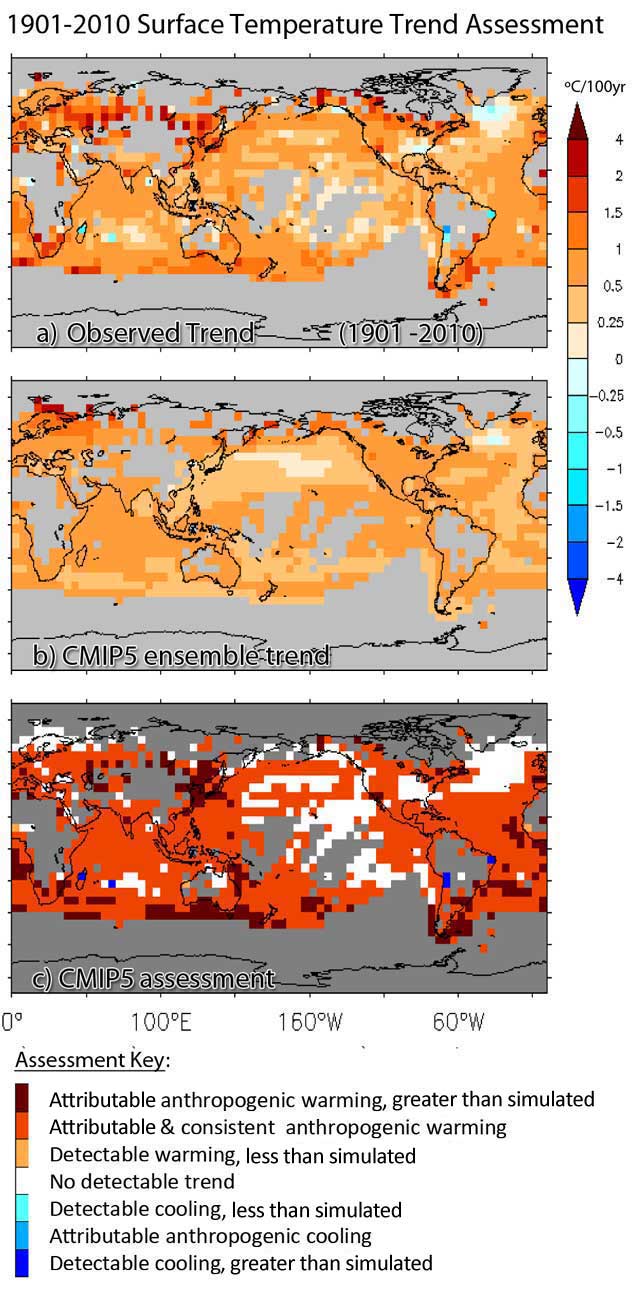August 30th, 2013
Key Findings
A comparison of observations and model simulations of surface temperature reveals that:
- The models are found to provide plausible representations of internal climate variability, though there is room for improvement.
- The influence of observational uncertainty on the trends is found to be generally small compared to intrinsic climate variability.
- Observed temperature trends over 1901-2010 are found to contain detectable anthropogenic warming components over a large fraction (about 80%) of the analyzed global area. This fraction is much smaller (~30%) for trends over the recent period 1981-2010.
- Although the global warming trend has been relatively small since 1998 (the so-called “warming hiatus”), the observed trend from 1998 to 2010 is not yet significantly different from the CMIP5 historical run ensemble.
Thomas R. Knutson, Fanrong Zeng, and Andrew T. Wittenberg. Journal: Journal of Climate. DOI:10.1175/JCLI-D-12-00567.1
Summary
Evaluating climate simulations against observational data is a fundamental step in the evaluation and eventual improvement of models. Models can also help test our understanding of the causes of past variations of climate seen in the historical record. This analysis shows how current climate models, including those developed by NOAA, compare with observations in terms of their regional surface temperature trends since 1901.
The authors assessed whether observed regional and global surface temperature trends are detectable and/or consistent with trends seen in the Climate Model Intercomparison Project (CMIP3 and CMIP5) models’ historical experiments. CMIP5 models are also used to detect whether there are anthropogenic components in the observed trends, by comparing “Anthropogenic + Natural Forcing” experiments against an alternative scenario involving only natural forcings.
At the grid-point scale and for various regions, up to and including the global scale, the consistency of modeled and observed surface temperature trends for various intervals of the 20th century are analyzed, taking into account uncertainties due to (1) the changing accuracy and data coverage of climate observations, (2) intrinsic variability of the climate system, and (3) intermodel diversity in the simulated response to radiative forcings. Observed temperature trends over 1901-2010 are found to contain detectable anthropogenic warming components over a large fraction (about 80%) of the analyzed global area (panel c).
Using our methodology, stakeholders in various regions can learn what state-of-the-art models say about whether anthropogenic warming has yet been detected in their particular region. The methodology provides some regional information down to a grid scale of about 500 km by 500 km (panel c).

Known uncertainties
The internal climate variability and climate response to forcings remain uncertain. Here these are estimated from multi-model ensembles. The models are found to provide plausible representations of internal climate variability, though there is room for improvement. Due to the limited set of model runs available, this multi-model ensemble of opportunity might not span the full range of uncertainty. The forcings and observed trends are also uncertain. However, the influence of observational uncertainty on the trends is found to be generally small compared to intrinsic climate variability. This study did not delve into the individual roles of anthropogenic forcing constituents, such as anthropogenic aerosols and greenhouse gases.


